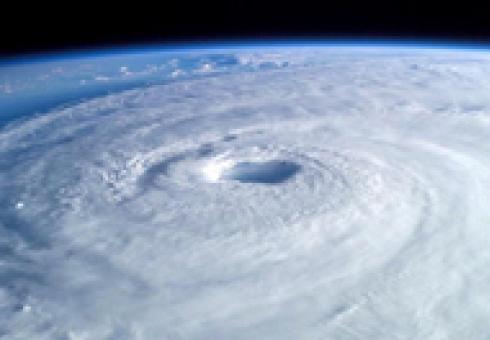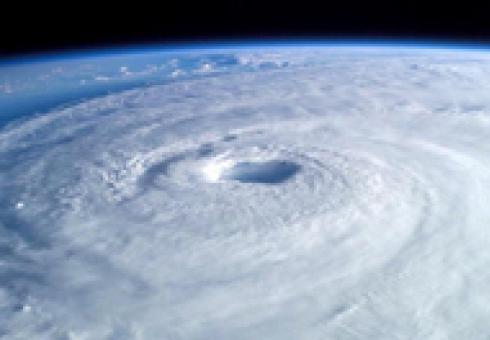CS3 In the News
This week, a reinvigorated Barack Obama returned to the White House knowing that he was poised on the edge of a fiscal cliff. Rather than relishing his victory last week, Obama must immediately set about crafting a compromise on deficit reduction with congressional leaders. The stakes could hardly be higher — for science, for US citizens and, indeed, for the world. In the event of failure, a budgetary time-bomb of tax increases and sweeping budget cuts will detonate on 2 January. As well as resulting in indiscriminate cuts to funds for scientific research and many other areas, it could knock the United States back into recession and deliver yet another blow to an already fragile global economy.
Faced with such dire consequences, one might expect that all the financial options would be on the table, especially the good ones. Unfortunately, this is not the case, at least not yet.
So far, lawmakers have rehashed long-standing disputes about the size of government and the social safety net, but have ignored ideas that could transform the fiscal challenge into an opportunity. One such proposal is the carbon tax, which could bring financial and political benefits for all and chart a new course forward for energy independence and global warming (see page 309). It is a solution that is every bit as improbable as it is logical, but one should remember Winston Churchill’s assessment of the United States’ tendency to do the right thing — once all the alternatives have been exhausted.
Just consider the possibilities. To put a levy on carbon would raise revenues that could be used to offset lower tax rates for individuals and businesses. This is what conservatives say they want to do. It would put more income — and thus choice — in the hands of consumers. Economists like the idea for more fundamental reasons. Generally, it is best to tax things that one wishes to discourage (such as smoking) rather than those that should be encouraged (such as working). Environmentalists like the idea of a carbon tax because it could generate some much-needed revenue for clean-energy research and development while reducing carbon emissions.
The numbers are not negligible. An analysis conducted in August by economists at the Massachusetts Institute of Technology (MIT) in Cambridge showed that a carbon tax of US$20 per tonne of carbon from fossil fuels, if instituted in 2013 and increased by 4% per year, would raise $1.5 trillion over the course of a decade. Averaged out, this amounts to $150 billion annually — a sizeable chunk of the trillion-dollar deficits that the US government has been running in recent years. Scholars at the Brookings Institution, a centrist think tank in Washington DC, advocate ramping federal investments in energy research up from $3.8 billion now to $30 billion annually, to drive down the cost of low-carbon energy (including cleaner-burning coal). It is an ambitious proposal, and would leave a pile of cash that could be redistributed elsewhere for beneficial use.
Conservatives loathe taxes, and US politicians obsess over energy prices, but a revenue-neutral carbon tax would get around these problems. The MIT analysis found that the economy benefited regardless of whether the money was reinvested in social programmes or redistributed in the form of lower taxes and cash payments to offset higher energy costs for the poor. For environmentalists, the problem with a carbon tax is that it does not technically limit emissions, but the MIT model suggests that it would perform quite well: carbon emissions fall to 14% below 2006 levels by 2020 as consumers and businesses find ways to reduce their energy use in response to higher prices.
Opposition to the idea may not be what it was. For example, on 13 November, the American Enterprise Institute hosted a conference in Washington DC on the economics of a carbon tax. The institute is a conservative think tank, and its officials have previously raised doubts about climate science. The idea has also been bubbling up in other right-leaning think tanks as a conservative solution to reduce greenhouse gases.
The problem is that to enact a carbon tax would depend on political courage and a willingness to break with party orthodoxy, rare traits in Washington today. President Obama has made energy and climate part of his agenda for the second term, but his first — and perhaps biggest — opportunity to make good on that promise will come in the next few weeks. As US politicians contemplate diving into the fiscal abyss, they would be wise to consider a painless policy that benefits everyone.
By Keith Johnson
With the fiscal cliff looming and parts of the U.S. still digging out from the aftermath of Hurricane Sandy, calls for the U.S. to adopt a carbon tax are gathering steam–even though there’s little sign of interest from Congress or the White House.
Today the conservative American Enterprise Institute is holding an all-day, on-the-record discussion of the idea. And the Brookings Institution is unveiling a slate of new measures meant to make the government more effective, including a carbon tax that could raise $1.5 trillion over ten years. All that follows a cascade of carbon-tax advocacy in recent days from the chattering classes and a slate of academic work over the summer (not to mention our own two cents).
The idea of a carbon tax is simple: Put a price tag on the harmful emissions from fossil fuels, such as oil and coal, and use the revenues to fund clean-energy development, pay down the deficit or slash taxes. Proponents often describe it as a win-win-win policy, because carbon taxes would penalize things that are bad (pollution) and lower taxes on things that are good (labor and capital).
“The time seems ripe for this discussion. The president is committed both to raising tax revenue and to dealing with climate change. A carbon tax kills two birds with one stone,” said Gregory Mankiw, a Harvard economist who advised the Romney campaign and has long pushed for more efficient taxation, including a carbon tax.
The Brookings proposal would impose a $20 fee on each ton of carbon, raising an average of $150 billion per year over a decade. Congress and the president would have to decide exactly how to use the money. Research by MIT and Brookings suggests that business-related tax breaks, whether corporate taxes or taxes on investment, would provide the biggest boost to economic growth and job creation.
But at least $30 billion a year should be earmarked for energy research and development, says Mark Muro, a senior fellow at the Brookings Metropolitan Policy Program. That’s because even a price on carbon emissions would not automatically make low-carbon energy such as wind, solar, geothermal and the like economically competitive with traditional fuels. Some research indicates that a $20 carbon tax would actually amount to less support for clean energy than the existing panoply of tax breaks and subsidies.
Alas for the wonks, a carbon tax is a new tax, and that isn’t a popular idea in Washington. Opponents of carbon taxes are rolling out their own intellectual artillery, arguing that the tax would stunt economic growth for little benefit. Grover Norquist, president of Americans for Tax Reform, said taxing energy consumption “would inevitably lead to higher taxes … even if originally passed with offsetting tax reductions elsewhere.”
Even one-time proponents of a carbon tax in Congress have disavowed the idea. While President Barack Obama mentioned climate change in his victory speech last week and has let the Environmental Protection Agency clamp down on emissions from coal-fired power plants, he has yet to outline any comprehensive plan to tackle climate change in his second term.
The carbon-tax crowd is a big tent, bringing together deficit hawks, growth mavens and climate worriers. The ideological diversity could be a plus–but only if advocates can leverage it to win political support from both sides of the spectrum.
By: Steven Mufson, November 9
Here’s a riddle: If Congress doesn’t want to raise income tax rates but wants to raise revenue, what can it do?
One answer: Pass a carbon tax.
A relatively moderate-sized carbon tax could raise $1.25 trillion over the next decade, a huge chunk of the money needed to bring the federal budget deficit under control. And the idea is getting a closer look now that the election is over and the “fiscal cliff” is looming.
Because it would tax fossil fuel use, the carbon tax pleases economists who want to encourage investment and discourage consumption. Climate activists hope it would reduce greenhouse-gas emissions by penalizing the use of coal, oil and natural gas. And for lawmakers opposed to any change in tax rates or deep cuts in spending, the carbon tax could be a lifeline.
“In the general scheme of things, taxes discourage whatever you’re taxing,” said William Pizer, associate professor of economic and environmental policy at Duke University. “If something is discouraged, it might as well be something bad like pollution instead of employment and savings.”
Pizer said that a $20-a-ton tax on carbon dioxide would raise gasoline prices by about 20 cents per gallon and boost electric bills slightly. It could be most efficiently collected “upstream,” at coal mines, oil and gas wells, or terminals for oil tankers arriving at U.S. shores.
There are drawbacks. Higher prices fall most heavily on lower-income earners who spend a larger portion of their pay on fuel. The tax would hurt certain regions more than others. It would need to be tweaked to protect firms that export to countries where companies don’t pay any carbon tax. It would also have to be reconciled with existing carbon trading schemes in the Northeast and California.
“Taxation is a painful thing, but this is one of the least inefficient ways of raising taxes,” said Nick Robins, head of the climate change center for banking giant HSBC. “At a time of low economic growth, it can be quite a good thing because it is taking costs out of the economy. If you can do that, it would be a good thing.”
As a matter of negotiating strategy, now might be a bad time for the Obama administration to advertise interest in a carbon tax. Doing so would make it a “lightning rod,” said Pizer, a former Treasury official. But, he added, once people see the pros and cons of other taxes and once they reach an impasse and need more revenues, a carbon tax might be an attractive alternative.
“From a policy-making point of view, it is clear that there is no way that this Congress is going to glom onto a carbon tax as an environmental policy,” said Philip R. Sharp, who served two decades in the House and is now president of Resources for the Future. “But it could become an important enabler for other things the Congress wants to do, namely eliminating the deficit and tax reform.”
In the past, conservatives have supported the idea of a carbon tax, though most of them have opposed using the receipts to swell government coffers.
N. Gregory Mankiw — a Harvard University economics professor, adviser to GOP presidential nominee Mitt Romney and former chairman of President George W. Bush’s Council of Economic Advisers — has long supported a carbon tax because he says the price of fossil fuels doesn’t reflect their true societal costs. In the past, he said he would use the receipts to lower other taxes.
In 2007, Kevin Hassett of the American Enterprise Institute, said a carbon tax would not only help energy security and attack global warming, it could also raise a quarter as much revenue as the corporate income tax and could be used to cut those rates.
In 2009, Exxon Mobil chief executive Rex Tillerson — in part to slow momentum toward a cap-and-trade system for reducing greenhouse-gas emissions — endorsed the carbon tax and said it should be set “somewhere north of” $20 a ton.
“As a businessman it is hard to speak favorably about any new tax. But a carbon tax strikes me as a more direct, a more transparent and a more effective approach,” he said at the time. He added that “a carbon tax is also the most efficient means of reflecting the cost of carbon in all economic decisions — from investments made by companies to fuel their requirements to the product choices made by consumers.”
But he, too, said it should be revenue neutral.
One leading GOP advocate of the carbon tax just flipped position. House member and Sen.-elect Jeff Flake (R-Ariz.) co-sponsored a carbon tax bill in 2009. But Friday, a spokesman told The Hill newspaper that Flake “has no plans to reintroduce it or support it as part of a tax reform package.”
The American Petroleum Institute (API) opposes a carbon tax. “Anytime we look at an energy issue, be it a tax or regulatory issue, we ask what does it do to promote or inhibit energy production and what is the impact on the American people,” said Jack Gerard, API president. “Clearly, it would increase costs to the American public. Is that what he [President Obama] wants to do? I would think not.”
But compared to the fiscal cliff , even a carbon tax might look attractive. A study by the Massachusetts Institute of Technology said “the economy is better off with the carbon tax than if taxes remain high to maintain Federal revenue.”
“We’ve been just surprised at the number of political groups across the political spectrum considering this,” said Sharp of Resources for the Future. “Contrary to what almost everybody universally would have said two years ago, we have gotten ourselves in such a pickle on the fiscal side of things that it opens up the possibility.”
(The author is a Reuters market analyst. The views expressed are his own.)
By Gerard Wynn
(Reuters) - Academics and lawmakers have proposed a U.S. carbon tax to curb carbon emissions and trim the debt pile, but the idea depends on prominent Republican support, so far absent.
Without a deal on cutting the fiscal deficit the United States faces a $600 billion package of automatic tax increases and spending cuts which could tip the country back into recession.
While that is clearly a step too far, the consensus is that a more gradual combination of spending cuts and/or tax hikes is required to avoid a borrowing crisis.
Many economists have argued for a carbon tax: it would lead to net welfare benefits compared with for example hikes in income tax, even before allowing for avoided climate change.
But it faces formidable problems.
It would acknowledge a climate threat, hike energy prices, hurt U.S. competitiveness (without including complicated compensating measures), and sound very much like a failed cap and trade bill.
To progress, supporters would have to paint a nightmare alternative including cuts in defense and social spending and income tax rises, and demonstrate clear daylight with a proposed cap and trade scheme which failed to win Congress approval in 2009.
Some energy executives and notably Exxon's chief executive have previously said they much prefer a carbon tax.
A cap and trade bill only narrowly passed the House of Representatives by 219-212 in June 2009 before mid-term elections saw Republicans take a House majority, and failed to pass the Senate.
PRICE
A carbon tax, or cap and trade scheme makes emitters pay for climate damage from burning fossil fuels and so drives a shift towards cleaner alternatives.
The notion of using carbon pricing to cut the U.S. budget deficit dates back to the Congressional Budget Office (CBO) report in March 2011, "Reducing the Deficit: Spending and Revenue Options."
The CBO reviewed cap and trade, or a carbon tax among 104 other options for raising tax revenues or cutting spending.
It reported that a scheme which applied a carbon price of $20 tax per tonne of CO2 would raise nearly $1.2 trillion by 2021.
Costs would be passed to energy consumers, its biggest political problem not always mentioned by economists, requiring some compensation which would steal funds from deficit cutting.
"The government could use some of those revenues to accomplish various goals such as reducing taxes, offsetting the costs of the cap-and-trade programme for certain groups or industries that are put at a competitive disadvantage by the programme, or reducing the federal deficit," the CBO report said.
ECONOMICS
A Massachusetts Institute of Technology (MIT) study in August found that a carbon tax would have a net economic benefit compared with allowing certain Bush-era tax cuts to expire, while still cutting the deficit.
Effectively they would swap one tax (on income, if Bush cuts expire on December 31) for another (on carbon).
The authors attributed the net economic benefit to a greater "drag" on the economy from income tax than a carbon tax.
The study did not quantify other benefits such as avoided climate change or lower crude oil imports, or try to compensate energy consumers.
"Given that all other options for dealing with the Federal deficit require difficult tradeoffs, it would seem hard to pass up one that offers so many advantages," the authors concluded in their paper "Carbon Tax Revenue and the Budget Deficit: A Win-Win-Win Solution?".
As Joseph Stiglitz said, in support of a carbon tax in his 2006 book "Making Globalisation Work":
"The country as a whole might be better off; it can use the revenue from the carbon tax to reduce other taxes, such as those on savings, investment, or work. These lower taxes would stimulate the economy, with benefits far greater than the cost of the carbon tax. This is consistent with a general economic principle: it is better to tax things that are bad like pollution than things that are good like savings or work."
ENERGY
Support from economists is one thing.
Given expected higher fossil fuel energy prices and therefore lower consumption, an endorsement by Exxon Chief Executive Rex Tillerson three years ago was more startling.
But that was in the context of shooting down cap and trade proposals when no alternative tax was suggested, and may therefore be more significant for rejecting one than supporting the other.
"As a businessman it is hard to speak favorably about any new tax. But a carbon tax strikes me as a more direct, a more transparent and a more effective approach (than cap and trade). It could be levied under the current tax code without requiring significant new infrastructure or enforcement bureaucracies," Tillerson told a Washington energy security conference in 2009, as quoted in the Exxon journal "The Lamp".
"A carbon tax is also the most efficient means of reflecting the cost of carbon in all economic decisions - from investments made by companies to fuel their requirements to the product choices made by consumers.
"Such a tax should be made revenue neutral. In other words, the size of government need not increase due to the imposition of a carbon tax. There should be reductions or changes to other taxes - such as income or excise taxes - to offset the impacts of the carbon tax on the economy."
POLITICS
The biggest practical problem of a carbon tax is softening its impact on energy consumers and energy-intensive industries.
The European Union has demonstrated that distribution problems can be solved, where for example power plants in poorer east European countries face a softer transition, and factories which face international competition get free emissions permits.
But political efforts now to raise European carbon prices face opposition from some member states, concerned about higher energy prices, even though it would raise funds for government coffers, in the same way as a U.S. tax.
In the face of undoubted, entrenched opposition from certain stakeholders including energy-intensive manufacturers and farmers, the only chance for a carbon tax in the United States is if Democrats prioritize it, and Republicans accept it as the least-worst option, for environmental legislation.
Whenever there’s an extreme weather event, from a hurricane to a record drought, the question always arises: Is it climate change?
MIT climate scientist Kerry Emanuel told Here & Now's Robin Young that it's hard to know for sure, but it is clear that as coastal waters warm up, storms will carry more rain, due to the added water vapor.

This NOAA satellite image taken on Monday shows Hurricane Sandy off the Mid
Atlantic coastline moving north. (AP/NOAA)
The policy community has long prophesied about the coming water wars. But don't expect them anytime soon. More likely, tensions over access will merely exacerbate existing regional conflicts.
By: Shlomi Dinar, Lucia De Stefano, James Duncan, Kerstin Stahl, Kenneth M. Strzepek, Aaron T. Wolf

Right: Looking south over the Mediterranean and down the Nile, from the International Space Station. (NASA / flickr)
The world economic downturn and upheaval in the Arab world might grab headlines, but another big problem looms: environmental change. Along with extreme weather patterns, rising sea levels, and other natural hazards, global warming disrupts freshwater resource availability -- with immense social and political implications. Earlier this year, the Office of the Director of National Intelligence published a report, Global Water Security, assessing hydropolitics around the world. In it, the authors show that international water disputes will affect not only the security interests of riparian states, but also of the United States.
In many parts of the world, freshwater is already a scarce resource. It constitutes only 2.5 percent of all available water on the planet. And only about .4 percent of that is easily accessible for human consumption. Of that tiny amount, a decreasing share is potable because of pollution and agricultural and industrial water use. All that would be bad enough, but many freshwater bodies are shared among two or more riparian states, complicating their management.
Of course, the policy community has long prophesied impending "water wars." In 2007, UN Secretary General Ban Ki Moon warned that "water scarcity ... is a potent fuel for wars and conflict." Yet history has not witnessed many. In fact, the only official war over water took place about 4,500 years ago. It was a conflict between the city-states of Lagash and Umma in modern day Iraq over the Tigris river. More recently, there have been some close calls, especially in the arid Middle East. About two years before the 1967 War, Israel and Syria exchanged fire over the Jordan River Basin, which both said the other was overusing. The limited armed clashes petered out, but the political dispute over the countries' shared water sources continues. In 2002, Lebanon constructed water pumps on one of the river's tributaries, which caused concern for downstream Israel. The project never provoked any formal military action, but with peace in the region already precarious, verbal exchanges between the two countries prompted the United States to step in. Both parties eventually accepted a compromise that would allow Lebanon to withdraw a predetermined amount of water for its domestic needs.
In short, predictions of a Water World War are overwrought. However, tensions over water usage can still exacerbate other existing regional conflicts. Climate change is expected to intensify droughts, floods, and other extreme weather conditions that jeopardize freshwater quantity and quality and therefore act as a threat-multiplier, making shaky regions shakier.
So what river basins constitute the biggest risks today? In a World Bank report we published in 2010 (as well as a subsequent article in a special issue of the Journal of Peace Research) we analyzed the physical effects of climate change on international rivers. We modeled the variability in river annual runoff in the past and for future climate scenarios. We also considered the existence and nature of the institutional capacity around river basins, in the form of international water treaties, to potentially deal with the effects of climate change.
According to our research, 24 of the world's 276 international river basins are already experiencing increased water variability. These 24 basins, which collectively serve about 332 million people, are at high risk of water related political tensions. The majority of the basins are located in northern and sub-Saharan Africa. A few others are located in the Middle East, south-central Asia, and South America. They include the Tafna (Algeria and Morocco), the Dasht (Iran and Pakistan), the Congo (Central Africa), Lake Chad (Central Africa), the Niger (Western Africa), the Nile (Northeastern Africa), and the Chira (Ecuador and Peru). There are no strong treaties governing the use of these water reserves in tense territories. Should conflicts break out, there are no good mechanisms in place for dealing with them.
By 2050, an additional 37 river basins, serving 83 million people, will be at high risk for feeding into political tensions. As is the case currently, a large portion of these are in Africa. But, unlike today, river basins within Central Asia, Eastern Europe, Central Europe, and Central America will also be at high risk within 40 years. Some of these include the Kura-Araks (Iran, Turkey, and the Caucasus), the Neman (Eastern Europe) Asi-Orontes (Lebanon, Syria, Turkey), and the Catatumbo Basins (Colombia and Venezuela).
CROSSING THE NILE
Among the larger African basins, the Nile has the greatest implications for regional and global security. Tensions over access to the river already pit Ethiopia and Egypt, two important Western allies, against one another. Egypt has been a major player in the Middle East Peace Process and Ethiopia is an important regional force in the Horn of Africa, currently aiding other African forces to battle Al-Shabbab in Somalia.
Over the years, a number of international water treaties have made rules for the basin, but they are largely limited to small stretches of it. In particular, only Egypt and Sudan are party to the 1959 Nile River Agreement, the principal treaty regarding the river. Egypt, which is the furthest downstream yet is one of the most powerful countries in the region, has been able to heavily influence the water-sharing regime. Upstream countries, such as Ethiopia and Burundi, have been left out, hard-pressed to harness the Nile for their own needs.
In 1999, with increasingly vitriolic rhetoric between Egypt and Ethiopia sidetracking regional development, the World Bank stepped up its involvement in the basin. It helped create a network of professional water managers as well as a set of investments in a number of sub-basins. Still, the drafting of a new agreement stalled: upstream countries would not compromise on their right to develop water infrastructure while downstream countries would not compromise on protecting their shares. In 2010, Ethiopia signed an agreement with a number of the other upstream countries hoping to balance against Egypt and Sudan. More recently, the country has also announced plans to construct a number of large upstream dams, which could affect the stability of the region.
By 2050, the environmental state of the Nile Basin will be even worse. That is why it is important to create a robust and equitable water treaty now. Such a treaty would focus on ways to harness the river's hydropower potential to satiate the energy needs of all the riparian states while maintaining ecosystem health. The construction of dams and reservoirs further upstream could likewise help even out water flows and facilitate agricultural growth. Projects such as these, mitigating damage to ecosystem health and local populations, would benefit all parties concerned and thus facilitate further basin-wide cooperation.
UP IN THE ARAL
Another water basin of concern is the Aral Sea, which is shared by Kazakhstan, Kyrgyzstan, Tajikistan, Turkmenistan, and Uzbekistan. The basin consists of two major rivers, the Syr Darya and Amu Darya. During the Soviet era, these two rivers were managed relatively effectively. The break-up of the Soviet Union, however, ended that. The major dispute now is between upstream Kyrgyzstan and downstream Uzbekistan over the Syr Darya. During the winter, Kyrgyzstan needs flowing water to produce hydroelectricity whereas Uzbekistan needs to store water to later irrigate cotton fields.
The countries have made several attempts to resolve the dispute. In particular, downstream Uzbekistan, which is rich in fuel and gas, has provided energy to Kyrgyzstan to compensate for keeping water in its large reservoirs until the cotton-growing season. Such barter agreements, however, have had limited success because they are easily manipulated. Downstream states might deliver less fuel during a rainy year, claiming they need less water from upstream reservoirs, and upstream states might deliver less water in retaliation. Kyrgyzstan, frustrated and desperate for energy in winter months, plans to build mega hydro-electric plants in its territory. And another upstream state, Tajikistan, is likewise considering hydro-electricity to satiate its own energy needs. Meanwhile, Uzbekistan is building large reservoirs.
Although these plans might make sense in the very near term, they are inefficient in the medium and long term because they don't solve the real needs of downstream states for large storage capacity to protect against water variability across time. In fact, both Kyrgyzstan and Uzbekistan, along with Kazakhstan, will see substantial increases in water variability between now and 2050. And so, the need to share the benefits of existing large-capacity upstream reservoirs and coordinate water uses through strong and more efficient inter-state agreements is unavoidable.
A stabilized Aral Sea basin would also benefit the United States. With its withdrawal from Afghanistan, Washington has been courting Uzbekistan as a potential alternative ally and provider of stability in the region. The Uzbek government seems willing to host U.S. military bases and work as a counter-weight to Russia. Kyrgyzstan is also an important regional player. The Manas Air Base, the U.S. military installation near Bishkek, is an important transit point. The country is also working with the United States to battle drug trafficking and infiltration of criminal and insurgent groups. Regional instability could disrupt any of these strategic relationships.
If the past is any indication, the world probably does not need to worry about impending water wars. But they must recognize how tensions over water can easily fuel larger conflicts and distract states from other important geopolitical and domestic priorities. Since formal inter-state institutions are key to alleviating tensions over shared resources, it would be wise, then, for the involved governments as well as the international community to negotiate sufficiently robust agreements to deal with impending environmental change. Otherwise, freshwater will only further frustrate stability efforts in the world's volatile regions.
SHLOMI DINAR is associate professor in the Department of Politics and International Relations and associate director of the School of International and Public Affairs at Florida International University. LUCIA DE STEFANO is associate professor at Complutense University of Madrid and researcher at the Water Observatory of the Botín Foundation. JAMES DUNCAN is consultant on natural resource governance and geography with the World Bank. KERSTIN STAHL is senior scientist at the Institute of Hydrology in the University of Freiburg. KENNETH M. STRZEPEK is research scientist with the Massachusetts Institute of Technology Joint Program on the Science and Policy of Global Change. AARON T. WOLF is a professor of geography in the College of Earth, Ocean, and Atmospheric Sciences at Oregon State University.
Maputo — Researchers from the Massachusetts Institute of Technology (MIT) and the United Nations have warned that Mozambique's infrastructure is vulnerable to extreme weather events that are becoming more frequent due to climate change.
According to MIT's Ken Strzepek, "in developing countries - and particularly in Africa - they are building their infrastructure at a very fast rate. They are also the most vulnerable to climate change impacts like flooding".
The researchers closely studied the projected change to Mozambique's climate and found that "it was clear that flooding and sea level rise would be two critical threats to the economy, and in particular to roads needed to transport food from rural farms to city populations".
Strzepek argues that "it would make sense for the government to spend the money now to build the roads in a way that makes them less vulnerable in the future".
Published in the "Review of Development Economics", the research on Mozambique finds that "climate change through 2050 is likely to place a drag on economic growth and development prospects. The economic implications of climate change appear to become more pronounced from about 2030. Nevertheless, the implications are not so strong as to drastically diminish development prospects".
The paper points out that "economic growth is widely held to depend on the quantity, quality, and orientation of a country's backbone infrastructure", and argues that the vulnerability of future infrastructure is "to a considerable degree, a matter of choice".
The researchers found that improved economic conditions in Mozambique have been felt by most segments of the population and that "the national poverty headcount fell from 69 to 55 per cent during 1997-2009, and infant mortality rates fell from 149 to less than 100 per 1000 births during 1996-2008. Education levels have also improved dramatically".
The authors of the report point out that "with agriculture accounting for about a quarter of Gross Domestic Product and three quarters of employment, improved rural infrastructure is often viewed as critical to future economic growth and poverty reduction".
They argue that "poor infrastructure, large distances, and associated weak market development generate large differences between farm gate and urban prices for agricultural products" and point out that "reducing these marketing margins results in strong poverty reductions, particularly if agricultural productivity rises simultaneously".
The researchers looked at four different climate change scenarios. Even in the scenario where Mozambique has a reduction in rainfall, there is a small increase in flooding although there is no increase in the probability of extreme flooding. In all the other cases, including the "global dry" scenario, the probability of extreme flooding events rises dramatically.
The paper concludes that "while the analysis conducted here does not favour a prophylactic policy of upgrading the road network, it should, in many instances, be reasonably obvious which portions of road are more likely to be subjected to flooding events. The concept extends well beyond roads. Indeed, the vulnerability profile of the large majority of the capital stock in 2050 is endogenous. By gradually channelling economic activity to areas less vulnerable to climate change (e.g. flooding events and sea level rise), the vulnerability of the economy can be greatly reduced, likely at very low cost. Simply accounting for the potential implications of climate change in decisions with respect to zoning and major public investments may be sufficient to substantially reduce the vulnerability profile in 2050 and beyond, when the implications of climate change are projected to manifest themselves with much greater force".
By: Washington Post/Associated Press
The issue:
People love to talk about the weather, especially when it’s strange like the mercifully ended summer of 2012. This year the nation’s weather has been hotter and more extreme than ever, federal records show. Yet there are two people who aren’t talking about it, and they both happen to be running for president.
Where they stand:
In 2009, President Barack Obama proposed a bill that would have capped power plant carbon dioxide emissions and allowed trading of credits for the right to emit greenhouse gases, but the measure died in Congress. An international treaty effort failed. Obama since has taken a different approach, treating carbon dioxide as a pollutant under the law. He doubled auto fuel economy standards, which will increase the cost of cars but save drivers money at the pump. He’s put billions of stimulus dollars into cleaner energy.
Mitt Romney’s view of climate change has varied. In his book “No Apology,” he wrote, “I believe that climate change is occurring” and “human activity is a contributing factor.” But on the campaign trail last year he said, “We don’t know what’s causing climate change on this planet.” He has criticized Obama’s treatment of coal power plants and opposes treating carbon dioxide as a pollutant and the capping of carbon dioxide emissions, but favors spending money on clean technology. Romney says some actions to curb emissions could hurt an already struggling economy.
Why it matters:
It’s worsening. In the U.S. July was the hottest month ever recorded and this year is on track to be the nation’s warmest. Climate scientists say it’s a combination of natural drought and man-made global warming. Each decade since the 1970s has been nearly one-third of a degree warmer than the previous one.
Sea levels are rising while Arctic sea ice was at a record low in September. U.S. public health officials are partially blaming unusually hot and dry weather for an outbreak of the deadly West Nile virus that is on pace to be the worst ever. Scientists blame global warming for more frequent weather disasters, with the World Health Organization saying: “Climatic changes already are estimated to cause over 150,000 deaths annually.” Others put the toll lower.
Emissions of carbon dioxide and other greenhouse gases from the burning of fossil fuels are trapping more of the sun’s heat on Earth. One study showed that 97 percent of the scientists who publish about climate in peer-reviewed journals say global warming is man-made. So do just about every major science society and institution that has weighed in.
But limiting carbon dioxide emissions from coal and oil would be costly, with billions of dollars in changes to the U.S. economy only a starting point. Similarly the price of not doing anything is extraordinarily high because of costly and deadly extreme weather. People will pay either way in taxes, energy prices, insurance premiums, disaster relief, food prices, water bills and changes to our environment that are hard to put a price tag on, says MIT economist Henry Jacoby.
A NASA study this year found the most extreme type of weather, which statistically should happen on less than 0.3 percent of the Earth at any given time, is now more common. Until recently, the most extreme year was in 1941 when extremes covered 2.7 percent of the globe. From 2006 to 2011 about 10 percent of the globe had that extreme weather, with a peak of 20 percent, the study said. That was before this year’s record extremes started.
The issue of man-made global warming is “totally missing” from the campaign between Obama and Romney, says Jacoby. It should be talked about, he says, because “we’re running a serious risk of passing a much-damaged planet to our descendants.”
By: Michael Vaughan
Two interesting issues that in the banality of the U.S. presidential campaign will likely never be discussed:
1. the extent of the sea ice covering the Arctic Ocean is now the smallest observed in the three decades since consistent satellite observations of the polar cap began, according to scientists from NASA;
2. an important study finds a carbon tax would enable the United States to find the means to both close the deficit gap and revive the economy.
While the two contenders are slanging each other about tax returns and birth certificates both surely know that NASA and MIT have to be taken seriously. Mitt Romney (not MIT) made his fortune in Boston and Barack Obama went to Harvard. MIT (Massachusetts Institute of Technology) has more new technology patents than most countries on Earth. Harvard has been lucky enough to have had among its alums a well-known billionaire who created Facebook plus eight who have became President of the United States.
When evidence becomes undeniable you have to wonder why those who make big decisions won’t discuss the evidence. Intelligent public policy matters. Yet the news is always obsessed about whether the teachers get their new raise or not. Meanwhile there are policy options that make a huge amount of sense that are never discussed, or even mentioned, in the daily news cycle.
The MIT study found that taxing carbon at $20 a ton in the U.S. would generate $1.5-trillion in revenue in a 10-year period, which would reduce corporate and personal income taxes, maintain social services spending and reduce the deficit.
“With the carbon tax there are virtually no serious trade-offs. Our analysis shows the overall economy improves, taxes are lower and pollution emissions are reduced,” said John M. Reilly, co-director of MIT’s Joint Program on the Science and Policy of Global Change. The study said the carbon tax would lower pollution by 20 per cent by 2050 and prevent oil imports from rising. It would also, most importantly, shift energy markets to clean technology.
Some Republications are coming around to the fact that the United States is facing the expiration of the “Bush” tax cuts in 2013 – the fiscal cliff. Even supply-side economists are reluctantly embracing a fee on carbon emissions. There are many global warming deniers in the GOP but others believe if the U.S. needs to raise revenue, why not just tax global warming pollution? The MIT analysis suggests that a carbon tax would be a more economically beneficial way of raising revenue than payroll or income taxes.
Additionally, the MIT report argues that a carbon tax would accomplish other important objectives. Fossil-fuel use would go down, oil imports would shrink slightly and U.S. carbon-dioxide emissions would decline. A carbon tax is tax levied on all carbon content of fuels. Carbon dioxide is a heat-trapping "greenhouse" gas. Carbon is present in hydrocarbon fuels – coal, petroleum, and natural gas – and is released as carbon dioxide (CO2) when they are burned. In contrast, non-combustion energy sources – wind, sunlight, hydropower and nuclear – do not convert hydrocarbons to CO2.
Yet, even with a carbon tax, the United States would still fall short of its long-term climate goals, which involve an 80 per cent cut in emissions below 1990 levels by mid-century. According to MIT calculations, a modest carbon tax, on its own, wouldn’t get the United States close to that longer-term mark; however, it would still make sense as a more economically efficient way of raising revenue.
If an intelligent public policy can improve the economy, reduce trade deficits, help the environment and keep the U.S. from going broke – why wouldn’t it at least be discussed in the election of the so-called most powerful person on Earth?
By: Kieran Mulvaney
As we approach the peak of this year's hurricane season, one question that is frequently asked - particularly in the wake of this summer's succession of extreme weather events - is whether hurricanes are becoming, or will become, more frequent or stronger as climate change strengthens its grip.
It's a question with which atmospheric scientists have been grappling for a relatively short amount of time, and as such the answer is something of a moving target. Were we to consult a climatological Magic 8 Ball, we might get a response like, ‘Outlook Uncertain, But Becoming Clearer.'
So we decided to do better and turn to one of the foremost authorities on the subject, Professor Kerry Emanuel of the Department of Earth, Atmospheric and Planetary Sciences at the Massachusetts Institute of Technology. Named one of Time Magazine's 100 Most Influential People in 2006, Prof. Emanuel has published extensively on the possible linkages between tropical storms and a warming planet, and he guided us through the complex haze of theory, modeling and observation.
DNews: At the risk of asking you to distill complex science into a simplistic soundbite: Is climate change affecting the number and intensity of cyclones and hurricanes?
Kerry Emanuel: Most of us think that we are seeing a climate change signal in the North Atlantic, which is by far the best observed and has been observed for the longest period of time; but I hasten to add that only about 12 percent of the world’s tropical cyclones occur in the Atlantic. The other parts of the world are not so well observed.
What we expect from a combination of theory and modeling is that as the climate warms, the actual total number of these storms should decline globally, but the incidence of the severe Category 3, 4 and 5 storms is expected on the other hand to go up. And we do see some indication that the proportion of hurricanes that are intense around the world has been going up, although our data is a bit tenuous and is not for very long, so nobody has a great deal of confidence in it.
Let me add that, historically it’s the Category 3, 4 and 5 hurricanes that do the vast majority of damage, at least in developing countries, so those are the ones we’re concerned about the most.
DNews: Is the theory behind this simply that a warming ocean provides greater energy for these storms to feed on? Is that a fair assessment?
Kerry Emanuel: It’s almost fair. What drives hurricanes is the flow of heat from the ocean to the atmosphere, and that is proportional to the difference between the heat content of the two, rather than the absolute temperature in either of them. But it turns out that if you add greenhouse gases to the atmosphere – or indeed, if you were just able to increase the amount of sunlight coming in, one way or the other – that increases the difference and so increases the potential for hurricanes, so that they could become stronger, at least theoretically.
DNews: And what would be the reason for the overall number of storms decreasing?
Kerry Emanuel: This is an interesting question. It bears on a related question, which is, ‘Why don’t we have hurricanes everywhere all the time?’ And the fact is that hurricanes are, fortunately for us, fairly rare. And yet, the conditions for hurricanes are prevalent over much of the tropics through much of the year. We’ve learned in recent decades that what stops most ordinary, run-of-the-mill disturbances from turning into hurricanes is the relative dryness of the atmosphere a couple of miles above the surface. Normally, it’s pretty dry there, but the relevant quantity is the difference between how much water is there, and how much water could be there if the air were saturated, and we call that the saturation deficit. And that deficit increases with temperature.
And because of that, as the temperature gets warmer and warmer, ironically it becomes more difficult to start a hurricane, even though once you start a hurricane, potentially it can become more intense, so you have these two contradictory things going on.
DNews: You mentioned that there is some indication tentatively of some greater intensity in the North Atlantic. Is that a consequence of better data and record-keeping in the North Atlantic, or would one expect a distinction between storms in the North Atlantic and other oceans?
Kerry Emanuel: I wish I could answer that question. I think the data in certain other places, like the western part of the North Pacific Ocean, at times in the past was better than today. We surveyed a lot of those storms with aircraft in the period between about 1945 and 1987, when that stopped for budgetary reasons. And we don’t see such a tight connection between hurricane power and temperature in the western North Pacific that we see in the Atlantic.
We’re not quite sure what is so special about the Atlantic. There are some indications that in the Atlantic kind of an alignment goes on. There are a lot of different things that affect hurricanes, not just temperature. The change in the incidence and intensity of hurricanes in the North Atlantic has been dominated more by temperature, by thermodynamics, whereas in other parts of the world some of these other factors, which are varying quite differently, may be more influential.
I should emphasize that it’s a young science, this connection between hurricanes and climate. We’re making progress and we are beginning to see a consensus developing in certain parts of the problem, but there is still a lot of it we don’t understand.
DNews: You anticipated my next question, which is: is there coming a time when you expect you will have enough of a data set to feel increasingly comfortable with these conclusions?
Kerry Emanuel: Well, the answer is a guarded yes. I think when it comes to the global levels of activity around the world, I can see light at the end of the tunnel, that we may indeed arrive at a consensus. When, on the other hand, it comes down to measures of hurricane activity that people care about – for example, the frequency of landfall of intense hurricanes in North America – whenever you get down to that telescopic level of detail, the models inevitably disagree violently with each other, and so scientists are left without much to go on.
And so when it comes to forecasting the things that people really care about, I don’t think there’s going to be much consensus about that for a very long time. We’re going to form a very strong consensus maybe about things that don’t really matter to people. After all, who really cares how many hurricanes occur in the Atlantic Ocean? We’re really only concerned at the end of the day with landfalling intense storms, and when you get down to that level, all bets are off at the moment.
DNews: My final question then is one you’re probably not comfortable with answering: Assuming a business-as-usual scenario of fossil fuel emissions, do you feel confident in predicting how the intensity and frequency of hurricanes in, say, 2050 might look compared to 2012, or is that a prediction you’re not comfortable with making?
Kerry Emanuel: I’m not comfortable with any predictions. Seeing into the future is pretty tough. I think we have to look at this problem from the point of view of ‘what does society do, and how do we react to this’? As a problem of risk. There’s a rsk that we’re going to have more intense hurricanes. We do know that there is terrific year-to-year volatility with hurricanes; that’s true in the present climate, it will be true in a future climate. So much so that, even if there were a strong global warming signal, we might see it right away in looking at metrics over the entire North Atlantic region, but when we look at metrics that we care about, like hurricane damage – which is caused by a tiny fraction of those events – we would need to wait decades before we see a signal in that.
So we’re in an awkward position. I think hurricane scientists are becoming better and better and better at looking for keys under the lamp, and eventually we’ll find them. But the things people care about aren’t under the lamp, and it will be a long time before we find those.
Let me mention one more thing, and that is that one aspect of hurricanes that people don’t talk about enough is rain. Historically, that’s been a very big killer: for example, the second-most-deadly hurricane in the western hemisphere was Mitch in 1998, and that (deadliness) was entirely due to freshwater flooding. We’ve seen recent examples in the US with Irene last year and Isaac this year. There’s a uniform consensus – one of the few things that we all agree on in hurricane science – that warming the atmosphere will increase the rainfall from hurricanes, and that should be a major concern.
IMAGES:
Hurricane Michael -- seen here on Sept. 6, 2012, with winds of 115 mph, in high resolution infrared imagery from the NOAA/NASA Suomi NPP satellite, was the first Atlantic storm of the 2012 season to reach Category 3 intensity. (NOAA)
Hurricane Isaac video grab (Whitney Shefte/The Washington Post)
By Ari Natter
WASHINGTON, D.C.--A tax on carbon dioxide emissions could raise $1.5 trillion, according to a Massachusetts Institute of Technology report that said the revenue could be used to stave off budget cuts as Congress seeks to reduce a looming federal deficit.
The report, Carbon Tax Revenue and the Budget Deficit: A Win-Win-Win Solution?, released Aug. 27, examined the effects of a carbon tax starting at $20 per ton in 2013 and rising 4 percent annually.
According to the report, such a tax would cut carbon dioxide emissions 20 percent below 2006 levels by 2050, encourage the use of renewables, and reduce oil imports.
“Whether we cut taxes or maintain spending for social programs, the economy will be better off with the carbon tax than if we have to keep other taxes high or cut programs to [rein] in the deficit,” John Reilly, an author of the study and the co-director of MIT's Joint Program on the Science and Policy of Global Change, said in a statement.
Alternative to Tax Increases, Defense Cuts.
The report, which comes as Congress seeks ways to reduce the federal deficit, says the revenue provided through a carbon tax could provide an alternative to tax increases and cuts to defense spending and social programs, and could allow an extension of the Bush tax cuts that are due to expire at the end of 2012.
However, the report's authors warn that “while in principle it is possible to get very positive results from a carbon tax, in practice” it depends on the specific proposal.
One, the Managed Carbon Price Act of 2012 (H.R. 6338), introduced earlier in August by Rep. Jim McDermott (D-Wash.), would place a carbon tax on fossil fuels but would set aside most of the revenues to be refunded to consumers, with the remainder being used for deficit reduction (149 WCCR, 8/2/12).
Still, many analysts remain skeptical that Congress has the appetite to enact carbon tax legislation anytime soon.
Climate legislation that would have required mandatory cuts in greenhouse gas emissions passed the House in 2009, but the Senate version collapsed in 2010.
By: Brad Plumer
With the United States facing the expiration of a slew of tax cuts in 2013—the dread “fiscal cliff”—there has been plenty of interest in offbeat tax-reform proposals. And one idea that a few economists keep knocking around is a fee on carbon emissions. After all, if we need to raise revenue, why not just tax global-warming pollution?
A new paper from the MIT Global Change Institute lays out how a carbon tax might work in practice. The authors model what would happen if, this December, Congress enacted a small fee on carbon emissions to fend off a portion of the tax hikes and spending cuts that are scheduled to occur. The carbon tax would be levied directly on fossil fuels—on coal that comes out of the mine, say, or oil that’s shipped in from overseas—and would start at $20 per ton of carbon in 2013, rising 4 percent each year thereafter.
The authors, Sebastian Rausch and John M. Reilly, estimate that this tax would raise $1.5 trillion over the next 10 years. If that revenue were then used either to cut income taxes, reduce payroll taxes, or deflect cuts to social-spending programs, the MIT authors find, most Americans would be slightly better off than if Congress simply let the fiscal cliff hit, with the Bush tax cuts and payroll tax cuts expiring automatically. (Using the carbon tax in this way would lead to an 0.02 percent bump in consumption and leisure over time.)
Now, the betting line is that Congress will do something to avert the looming tax hikes and spending cuts, so this isn’t a terribly realistic scenario. Implementing a carbon tax next year would still hurt the economy—it would just hurt slightly less than the fiscal cliff. Still, the broader point of the MIT analysis is to suggest that a carbon tax could be a more economically beneficial way of raising revenue than, say, payroll or income taxes. So even if Congress waited until 2014 or 2015 or whenever the U.S. economy has recovered, replacing other taxes with a carbon tax could still provide a minor economic boost (see the first graph below).
A carbon fee usually gets criticized for hurting poorer Americans the most—they spend the biggest slice of their income on gasoline and other energy-intensive products, after all. But Rausch and Reilly found that a lot of the distributional effects depend on what Congress does with the revenue, as shown in the chart below:

CTCorp = carbon tax used to cut corporate tax rate, CTPersInc = carbon tax used to cut income tax rate, CTPayroll = carbon tax used to cut payroll taxes, CTTransfer = carbon tax used to bolster social welfare programs like Medicaid
The green line shows how different income groups would be affected in 2015 if the carbon tax was used to fend off cuts to social welfare programs like Medicaid. Lower-income Americans would benefit significantly, while wealthier Americans would take a small hit. By contrast, the red and blue lines show the effects if revenue from the carbon tax was used to cut the corporate tax or personal income tax—in those cases, higher-income Americans would come out ahead. If, however, a carbon tax was used to cut payroll taxes—that’s the black line—then the welfare effects in 2015 are more or less neutral.
The MIT report argues that a carbon tax would accomplish a few other things as well. Fossil-fuel use would go down, oil imports would shrink slightly, and U.S. carbon-dioxide emissions would decline. On that last point, however, it’s worth noting that the carbon tax proposed by the MIT study only gets the United States a fraction of the way toward its long-term climate targets, as shown in this graph:

Blue line: MIT reference case with no carbon tax. Black line: EIA reference. Green line: Scenario with MIT carbon tax in place.
With the carbon tax proposed by MIT (that’s the green line in the chart above), U.S. emissions would be 14 percent below 2006 levels by 2020 and 20 percent below 2006 levels by 2050. That’s lower than if there was no carbon tax at all.
Yet the United States would still fall short of its long-term climate goals, which involve an 80 percent cut in emissions below 1990 levels by mid-century. According to MIT calculations, a modest carbon tax, on its own, wouldn’t get the United States close to that longer-term mark. It might make sense as a more economically efficient way of raising revenue. But the tax would either have to be hiked dramatically or combined with other clean-energy measures in order to make a significant dent in tackling global warming.













